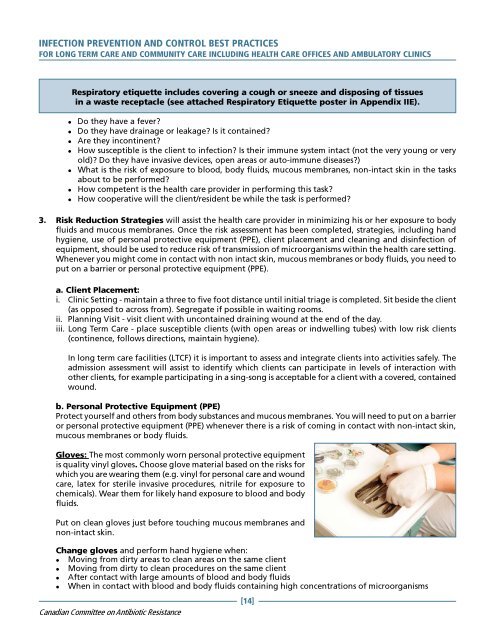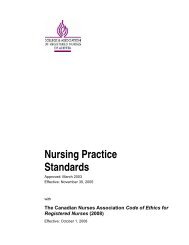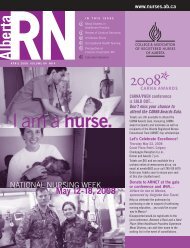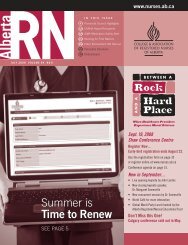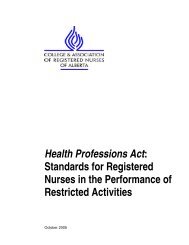Infection Prevention and Control Best Practices - College ...
Infection Prevention and Control Best Practices - College ...
Infection Prevention and Control Best Practices - College ...
You also want an ePaper? Increase the reach of your titles
YUMPU automatically turns print PDFs into web optimized ePapers that Google loves.
INFECTION PREVENTION AND CONTROL BEST PRACTICES<br />
FOR LONG TERM CARE AND COMMUNITY CARE INCLUDING HEALTH CARE OFFICES AND AMBULATORY CLINICS<br />
Respiratory etiquette includes covering a cough or sneeze <strong>and</strong> disposing of tissues<br />
in a waste receptacle (see attached Respiratory Etiquette poster in Appendix IIE).<br />
� Do they have a fever?<br />
� Do they have drainage or leakage? Is it contained?<br />
� Are they incontinent?<br />
� How susceptible is the client to infection? Is their immune system intact (not the very young or very<br />
old)? Do they have invasive devices, open areas or auto-immune diseases?)<br />
� What is the risk of exposure to blood, body fluids, mucous membranes, non-intact skin in the tasks<br />
about to be performed?<br />
� How competent is the health care provider in performing this task?<br />
� How cooperative will the client/resident be while the task is performed?<br />
3. Risk Reduction Strategies will assist the health care provider in minimizing his or her exposure to body<br />
fluids <strong>and</strong> mucous membranes. Once the risk assessment has been completed, strategies, including h<strong>and</strong><br />
hygiene, use of personal protective equipment (PPE), client placement <strong>and</strong> cleaning <strong>and</strong> disinfection of<br />
equipment, should be used to reduce risk of transmission of microorganisms within the health care setting.<br />
Whenever you might come in contact with non intact skin, mucous membranes or body fluids, you need to<br />
put on a barrier or personal protective equipment (PPE).<br />
a. Client Placement:<br />
i. Clinic Setting - maintain a three to five foot distance until initial triage is completed. Sit beside the client<br />
(as opposed to across from). Segregate if possible in waiting rooms.<br />
ii. Planning Visit - visit client with uncontained draining wound at the end of the day.<br />
iii. Long Term Care - place susceptible clients (with open areas or indwelling tubes) with low risk clients<br />
(continence, follows directions, maintain hygiene).<br />
In long term care facilities (LTCF) it is important to assess <strong>and</strong> integrate clients into activities safely. The<br />
admission assessment will assist to identify which clients can participate in levels of interaction with<br />
other clients, for example participating in a sing-song is acceptable for a client with a covered, contained<br />
wound.<br />
b. Personal Protective Equipment (PPE)<br />
Protect yourself <strong>and</strong> others from body substances <strong>and</strong> mucous membranes. You will need to put on a barrier<br />
or personal protective equipment (PPE) whenever there is a risk of coming in contact with non-intact skin,<br />
mucous membranes or body fluids.<br />
Gloves: The most commonly worn personal protective equipment<br />
is quality vinyl gloves. Choose glove material based on the risks for<br />
which you are wearing them (e.g. vinyl for personal care <strong>and</strong> wound<br />
care, latex for sterile invasive procedures, nitrile for exposure to<br />
chemicals). Wear them for likely h<strong>and</strong> exposure to blood <strong>and</strong> body<br />
fluids.<br />
Put on clean gloves just before touching mucous membranes <strong>and</strong><br />
non-intact skin.<br />
Change gloves <strong>and</strong> perform h<strong>and</strong> hygiene when:<br />
� Moving from dirty areas to clean areas on the same client<br />
� Moving from dirty to clean procedures on the same client<br />
� After contact with large amounts of blood <strong>and</strong> body fluids<br />
� When in contact with blood <strong>and</strong> body fluids containing high concentrations of microorganisms<br />
Canadian Committee on Antibiotic Resistance<br />
[14]


